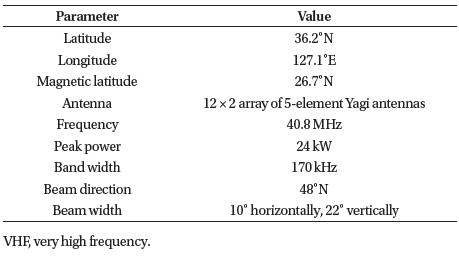1. INTRODUCTION
Extensive studies of E-region field-aligned irregularities (FAIs) have been made in the equatorial (e.g., Fejer & Kelley 1980), low-latitude (e.g., Patra & Rao 1999) and auroral regions (e.g., Haldoupis 1989) with radars and in situ measurements. In middle latitudes, investigation of E-region FAIs was started with the observation of sporadic E (Es) at an altitude of ~105 km using a portable 50-MHz Doppler radar on the island of Guadeloupe in French West Indies near Arecibo, Puerto Rico (Ecklund et al. 1981).
In the last three decades, intensive efforts, both observational and theoretical, have been devoted to achieving a better understanding of E-region FAIs in midlatitudes using the Middle and Upper atmosphere (MU) radar in Shigaraki (34.89°N, 136.10°E, 25.7°N dip latitude), Japan (e.g., Fukao et al. 1985a, b, 1991). Investigations using observations from the MU radar have revealed the essential features and characteristics of mid-latitude E-region FAIs. In MU radar observations, Yamamoto et al. (1991) first recognized two types of radar echoes in the middlelatitude E-region: “quasi-periodic (QP)” echoes appearing intermittently at altitudes above 100 km with periods of 5–20 min from post-sunset time to midnight, and “continuous” echoes appearing continuously at altitudes of 90–100 km mainly during the post-sunrise period. Several studies have been conducted to investigate the generation mechanism of the post-sunset QP echoes in the middle latitude. As a factor in the generation mechanism of QP echoes, Woodman et al. (1991) pointed out that atmospheric gravity waves could modulate Es layers to keep the plasma unstable, accounting for its quasi-periodicity. Later, Tsunoda et al. (1994) modified the theory of Woodman et al. (1991) to suggest that a polarization electric field resulting from spatial modulation of the Es layers due to a gravity wave may play a role in generating the QP echoes. The SEEK (Sporadic-E Experiment over Kyushu) (e.g., Fukao et al. 1998;Tsunoda et al. 1998;Yamamoto et al. 1998) and SEEK-2 (Sporadic-E Experiment over Kyushu-2) (e.g., Saito et al. 2005;Yamamoto et al. 2005) were conducted in order to reveal the generation mechanism of QP echoes in the mid-latitude Es layers. From both campaigns, it was found that polarization electric fields were induced from the Es layer with QP echoes, mapped upward along the geomagnetic field, and played an essential role in determining the structures of the whole ionospheric E-region. Otsuka et al. (2007) observed E-region FAIs and medium-scale traveling ionospheric disturbances (MSTIDs) using very high frequency (VHF) radar and 630-nm airglow images simultaneously. They reported that the electric fields associated with the F-region MSTIDs could be closely coupled to those associated with QP echoes in the E-region.
MU radar observations, however, have never shown the E-region irregularities that occurred during the afternoon (i.e., from noon to sunset time). No afternoon E-region FAIs in the middle latitude have been reported yet. On the other hand, a 40.8 MHz VHF radar operated continuously since 29 December 2009 at Daejeon (36.18°N, 127.14°E, 26.7°N dip latitude) in South Korea has often observed E-region FAIs in the afternoon. In this paper, therefore, for the first time, we report afternoon observations of the mid-latitude E-region FAIs made by the Daejeon radar. In section 2, we describe in detail the experiment of the Daejeon radar. Section 3 presents the statistical characteristics of the midlatitude afternoon E-region FAIs based on the continuous radar observations. Moreover, to investigate the afternoon E-region FAIs-Es relationship, in section 4, the FAIs have also been compared with Es parameters derived from an ionosonde located at Icheon (37.14°N, 127.54°E, 27.7°N dip latitude), which is 100 km north of Daejeon. Our main findings are summarized in section 5.
2. EXPERIMENT DESCRIPTION
A VHF coherent scattering radar was built at Daejeon (36.18°N, 127.14°E, 26.7°N dip latitude) in South Korea, aiming to continuously monitor middle-latitude FAIs in the Far East Asian sector. Daejeon VHF radar operates at 40.8 MHz and has a maximum transmit power of 24 kW. Table 1 summarizes the basic parameters and technical specifications of our radar. A total of 24 5-element Yagi antennas have been installed in a 12 × 2 phased array on an area of 85 m × 40 m. The radar beam is directed at a 48° zenith angle in the magnetic north direction to be perpendicular to the magnetic field lines at the E- and F-region heights so that backscattering of E- and F-region irregularities can be detected, and half-power full beamwidths in horizontal and vertical directions are 10° and 22°, respectively. The radar has been operating routinely, sampling the E- and F-regions for one minute. The radar parameters used for E-region observation are given in Table 2. The inter-pulse period (IPP) for the E-region experiments is 2.5 ms, and the pulse width is 6 μs, so the range resolution of the VHF radar measurements for the E-region is 900 m. The FAIs detected by the 40.8 MHz radar correspond to a scale size of 3.68 m (half wavelength of the transmitted pulse). More detailed information on the radar experiment and data analysis can be found in Kwak et al. (2014) and Yang et al. (2015). During the radar observation periods, ionograms have been obtained at 15-min intervals using a digital ionosonde, having a sweep frequency range from 1 MHz to 20 MHz, operated routinely from Icheon (37.14°N, 127.54°E, 27.7°N dip latitude), which is 100 km north of Daejeon. We obtained three parameters of Es: virtual height of Es (h’Es); top frequency (ftEs), the maximum frequency at which the E-region echoes are observed; and blanketing frequency (fbEs), the lowest frequency at which the F-region echoes are observed.
Fig. 1 illustrates the geometry of the Daejeon VHF radar and Icheon ionosonde experiments. The locations of the radar and ionosonde are marked with a black dot and a black square, respectively. The latitudinal curves with altitude information show the loci where the radar ray paths are perpendicular to the geomagnetic field at various E-region heights, assuming straight-line ray propagation paths.
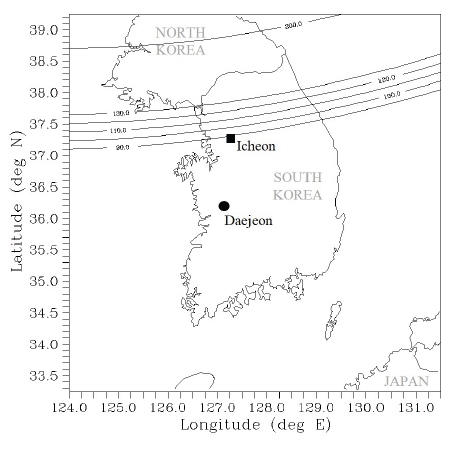
3. OBSERVATIONS OF AFTERNOON E-REGION FAIS IN MIDDLE LATITUDE
Since its installation in December 2009, the VHF coherent scattering radar at Daejeon has been operating for E- and F-region ionospheric FAI research. Data were collected in spectral power form and stored for post-analysis, then spectral characteristics were parameterized in terms of signal-to-noise ratio (SNR), Doppler velocity, and spectral width.
Figs. 2(a)–2(c) present the range-time variations of SNR, Doppler velocity, and spectral width between 09:00 and 23:00 LT on 22 June 2011. The echo height is on the right axis of the figure and is calculated by multiplying the echo range by Cos 48° (≒ 0.669). For the morning time from 09:00 to 10:00 LT, the weak continuous type echoes (SNR ≤ 10 dB) are found at altitudes between 105 km and 110 km. In the postsunset period just after sunset (20:25 LT), strong QP type echoes (maximum SNR ~30 dB) are observed at about 120 km to 140 km altitude. While the characteristics of the postsunrise continuous and post-sunset QP echoes in middle latitudes are already understood thanks to the MU radar observations (e.g., Yamamoto et al. 1991, 1992, 1994;Ogawa et al. 1995, 2002), little was known about the mid-latitude E-region echoes from noon to sunset. Indeed, although radar probing of the mid-latitude E-region ionospheric electron density irregularities has been carried out for several decades, so far, no afternoon E-region FAIs in middle latitude have been reported as of yet. In Fig. 2(a), however, at Daejeon, very strong continuous-like type afternoon echoes are seen at about 100 km to 135 km altitude with a thickness of 35 km, centered at about 115 km altitude, from 14:00 to 20:30 LT. The maximum SNR of the echoes is ~30 dB. This value is similar to that of the post-sunset QP echoes and is more intensive than that of the post-sunrise continuous echoes. In Fig. 2(b), the Doppler velocities are almost positive except between 16:00 and 17:30 LT, indicating that FAIs are moving away from the radar (or upward velocities). The absolute magnitude of the Doppler velocities of the afternoon echoes is mostly less than 30 m/s. This magnitude is smaller than that in the post-sunset QP echoes, and is similar to that of the post-sunrise continuous echoes. In Fig. 2(c), the spectral widths of the Doppler velocity of the afternoon echoes are mostly very low (maximum spectral width ~10 m/s). This magnitude is smaller than those of the post-sunset QP and the post-sunrise continuous echoes.
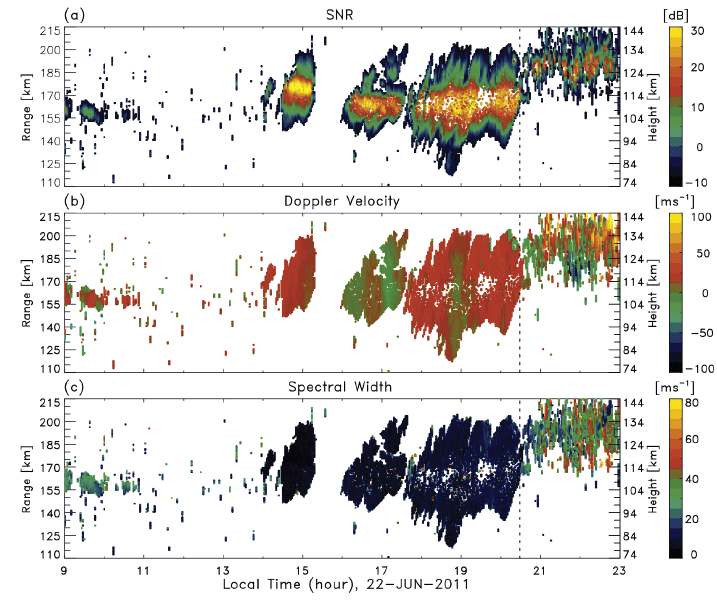
Fig. 3 shows seasonal and local time variations of the E-region FAI occurrence observed by the VHF radar at Daejeon, South Korea, from 2010–2017. An SNR larger than −10 dB was regarded as echoes from FAIs. The occurrence and non-occurrence of FAI echoes from the radar are represented by the red and blue sections, respectively. The white area in Fig. 3 indicates times at which there was no observation due to instrument problems, and the white dotted and dashed lines represent the noontime, the sunset time, and the sunrise time, respectively, against the day of the year. In this study, we observe that the occurrence of the afternoon E-region irregularities between noon and sunset time is especially frequent.
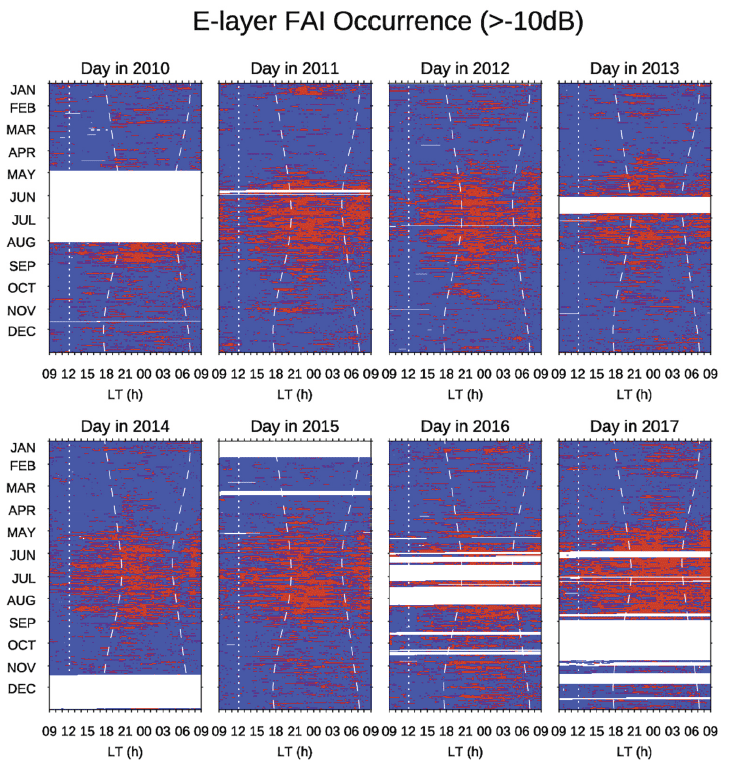
From Fig. 3, it should be noted that we encountered significant data loss except for 2011 and 2012. For this reason, as we could not get meaningful information on the occurrence of the afternoon E-region FAIs during 2010 and 2013–2017 due to this data loss, we present echo occurrence statistics and characteristics for the afternoon E-region FAIs (i.e., irregularities between noon and sunset time) obtained from observations made during 2011–2012 hereafter. Fig. 4 illustrates the seasonal percentage occurrence of the afternoon E-region FAIs as a function of local time observed from the Daejeon VHF radar for spring (March, April, May), summer (June, July, August), fall (September, October, November), and winter (December, January, February) seasons during 2011–2012. It is observed that the occurrence of afternoon E-region FAIs has a strong seasonal dependence, with maxima in summer, minima in winter, and moderate occurrence during the equinox season. The afternoon E-region FAIs for the summer season are more likely to occur at 12–20 LT with a peak occurrence (~29%) around 19–20 LT. The peak occurrence (~5%) of afternoon E-region FAIs is seen around 15–16 LT for the winter season. The occurrence of afternoon E-region FAIs for equinox is higher than for winter solstice, mainly due to the enhanced occurrence of afternoon E-region FAIs during the autumnal equinox.

Figs. 5(a)–5(d) present percentage distributions of the SNR, Doppler velocity, spectral width, and height of the afternoon E-region FAIs observed from the Daejeon VHF radar during 2011–2012. The SNRs vary between −10 dB and 35 dB, with maximum occurrence probability as high as 29% around −10 dB. Doppler velocities are found to be mostly within ± 40 m/s, with maximum occurrence probability as high as 38% around −10 m/s. Most spectral widths are close to zero. This indicates that the strong irregularities are not related to turbulent plasma motions. The afternoon E-region FAIs occur around altitudes of 100–135 km.

4. RELATION BETWEEN AFTERNOON E-REGION FAIS AND ES LAYERS
The sporadic E layer within the E-region is a very thin layer of extremely dense electrons relative to that of the surroundings. The electron density at Es is usually 2 or 3 times greater, and sometimes it reaches F-region electron density. Wind shear theory (Whitehead 1989) with long-lived metallic ions is a well-known mechanism of Es in the middle latitude. In general, E-region FAIs in the middle latitude are related to the level of Es activity, and several studies (e.g., Yamamoto et al. 1992;Hussey et al. 1998;Ogawa et al. 2002;Maruyama et al. 2006) have sought to understand the relationship with Es. However, the studies showed the results in time zones other than the afternoon zone. For this reason, we investigate the relationship between the afternoon E-region FAIs at a middle latitude and variations of the Es layers. To accomplish this, we compare the variations in the afternoon Es parameters observed from Icheon ionosonde with the variations in the afternoon E-region FAIs observed over Daejeon.
In Figs. 6(a) and 6(b), we present examples of SNR of afternoon E-region FAIs from the Daejeon radar and the virtual height of Es (h’Es) from Icheon ionosonde on 22 June and 28 July 2011. Color contours represent the range-time SNR maps of the afternoon E-region FAIs, and circle-solid lines in green represent h’Es. These figures clearly show that the h’Es is located on average in the 105–110 km altitude range, and these altitudes will be 5–10 km higher than the FAI bottom side. The high elevation values commonly observed during daytime can be attributed to the group delay effect on daytime HF frequencies due to underlying ionization. Lee et al. (2000) found that the h’Es was in the range of 100–110 km altitude and considered these heights to be 5–10 km higher than actual heights, depending on the underlying ionization.
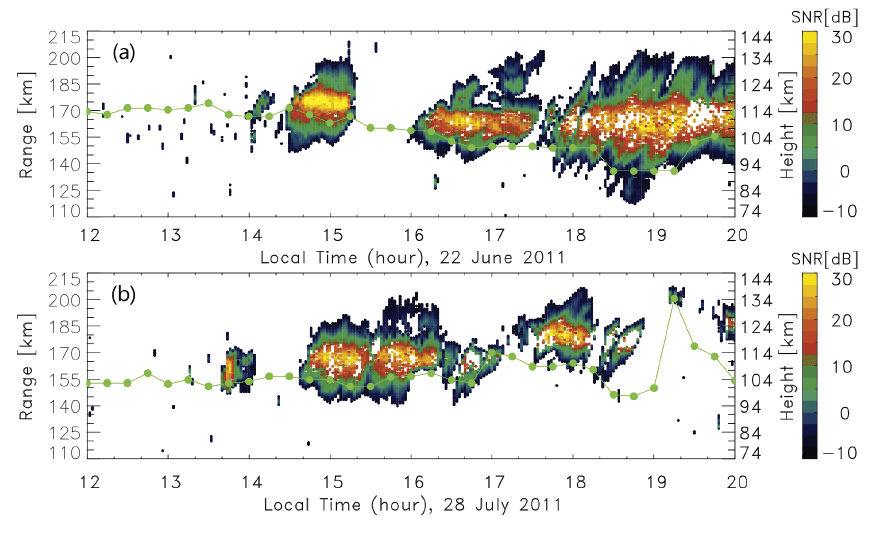
According to recent studies on the mid-latitude Es (Hussey et al. 1998;Ogawa et al. 2002;Maruyama et al. 2006;Patra et al. 2009;Phanikumar et al. 2008, 2009), the top frequency (ftEs) corresponds to the local maximum electron density of a non-uniform layer or the peak electron density of a spatially uniform layer, and the blanketing frequency (fbEs) is the minimum value among the peak electron densities of the layer. For a non-uniform Es layer, the difference between ftEs and fbEs was found to be related to the irregularities present in the Es layer, albeit on a larger scale than those observed by VHF radars. In this study, we used ftEs and fbEs to represent the maximum and minimum values of the peak electron density in the Es layer, respectively, and (ftEs–fbEs) as representative of irregularities. Fig. 7 shows seasonal and local time distributions of Es parameters observed from Icheon ionosonde and peak SNR of the afternoon E-region FAIs observed from Daejeon radar in 2011. In these figures, we have shown ftEs in the top panels, fbEs in the second panels, (ftEs–fbEs) in the third panels, and peak SNR of the afternoon E-region echoes in the bottom panels. Concerning the relationship of afternoon FAIs with Es activities, as is evident from Figs. 7(a)–7(d), SNR of the afternoon E-region FAIs is poorly correlated with both ftEs and fbEs and reasonably well correlated with (ftEs– fbEs). Almost no correlation between FAIs and fbEs indicates that commonly occurring blanketing Es is insufficient for the generation of the E-region afternoon irregularities in the middle latitude. Instead, large values of (ftEs–fbEs) probably increase the SNR of FAIs, implying that patchytype Es structures must be responsible for the excitation of irregularities.
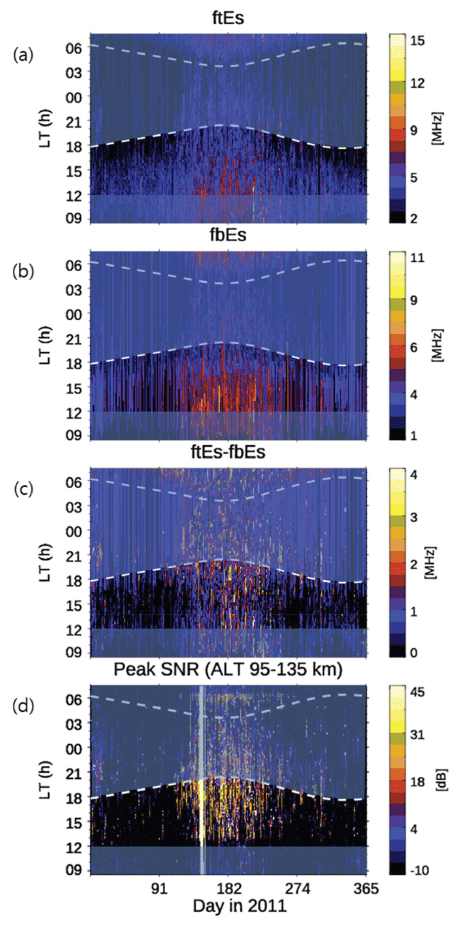
Using the MU radar and ionosonde from Shigaraki in Japan, Yamamoto et al. (1992) found that the QP radar echoes from the mid-latitude E-region in the nighttime were correlated with Es activity. In addition, based on simultaneous observations of FAIs and Es from middle latitude, Ogawa et al. (2002) and Maruyama et al. (2006) found good correlation between the QP radar echoes and the enhanced value of (ftEs–fbEs). Yamamoto et al. (1992), however, found that the radar echoes from the mid-latitude E-region were not detected in the summer afternoon when ionosonde observed maximum Es activity. Similar results have been reported from Chung-Li, Taiwan (Lee et al. 2000). On the other hand, E-region observations from Daejeon VHF radar and Icheon ionosonde clearly show that significant afternoon FAIs are detected, especially in summer season, and are correlated with Es (especially, ftEs– fbEs). Based on these different observations in the midlatitude E-region, the generation of FAIs is closely related to localized density gradients within the Es layer that provide favorable conditions for the growth of instability.
5. CONCLUSION
In this paper, for the first time, we present the characteristics and statistical morphology of the midlatitude afternoon E-region FAIs based on the continuous observations from the VHF coherent backscatter radar at Daejeon in South Korea. The main findings of this paper are as follows.
First, it is observed that the occurrence of the afternoon E-region FAIs in the middle latitude is maximum during the summer season and minimum during the winter season.
Second, the echo SNR of the afternoon E-region FAIs in middle latitude is found to be as high as 35 dB, mostly occurring around 100–135 km altitudes. Most spectral widths of the afternoon echoes are close to zero, indicating that the irregularities during the afternoon time are not related to turbulent plasma motions.
Third, the afternoon E-region FAIs-Es relationship has been investigated based on Daejeon radar observations and Es parameters made from an ionosonde located at Icheon, which is 100 km north of Daejeon. It is found that the virtual heights of Es (h’Es) are mainly in the height range of 105–110 km, and these heights are 5–10 km greater than the FAI bottom side. No relation is found between FAIs SNR and top frequency (ftEs) (or blanketing frequency (fbEs)). Instead, it is supposed that large values of (ftEs–fbEs) enhance the SNR of FAIs, suggesting that patchy-type Es structures must be responsible for the excitation of irregularities.
